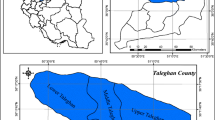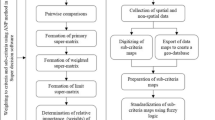Abstract
Identification of capacities for development of ecotourism is an undeniable priority in any country. For this purpose, various methods have been proposed by different researchers for locating regions with a potential for the development of ecotourism. These regions have different strong and weak points depending on the regional conditions. Evidently, the use of quantitative methods and reduced expert involvement in the process of decision-making and evaluation can yield better results. Therefore, in this research, a multi-criteria evaluation method based on fuzzy logic and network analysis process (ANP) has been used for the evaluation of the development of ecotourism. Therefore, one of the semi-northern regions of the country—Taleghan county, Alborz province—which has different capacities regarding ecotourism was chosen and investigated. Ecological and socio-economic criteria and indices were first identified and then quantified by fuzzy method, after which they were normalized. Further, the weight of factors was determined by the ANP method. Thereafter, using weight linear combination (WLC) operator, all the layers were combined and the region’s potential for ecotourism was zoned. The outcomes show that out of the entire area, 75.2% has different abilities for ecotourism development, while the remaining area lacks any special ability. Further, the results of the research indicate that the concurrent use of fuzzy logic and ANP method in determining the priority and weight of criteria provides more logical and flexible conditions compared to other methods for land evaluation in the context of the mentioned aim through WLC method.



Similar content being viewed by others
References
Abidin ZZ (1995) The identification of criteria and indicators for the sustainable management of ecotourism in Taman Negara National Park, Malaysia: A Delphi consensus. Ph.D. Dissertation. Forestry and Consumer Sciences. West Virginia University
Amir Ahmadi A, Mozaffari H (2012) Analysis of suitable place for ecotourism development in Zanjan Province using Geographic Information Systems. Q J Geogr Res 27(3):135–150
Andrea EG, Binford MW, Southworth J (2009) Tourism, forest conversion, and land transformations in the Angkor basin, Cambodia. Appl Geogr 29:212–223
Ashouri P, Faryadi Sh (2010) Potential assessment of nature-based tourism destinations using MCA techniques case study: Lavasan-e Koochak. J Environ Stud 36(55):1–12
Balli A, Monavari M, Riazi B, Khorasani N, KheirkhahZarkesh M (2015) A spatial decision support system for ecotourism development in caspian hyrcanian mixed forests ecoregion. Bol. Ciênc. Geod. sec. Artigos, Curitiba 21(2): 340–353
Barzekar G, Aziz A, Mariapan M, Ismail MH, Hosseni SM (2011) Delphi technique for generating criteria and indicators in monitoring ecotourism sustainability in Northern forests of Iran; case study on Dohezar and Sehezar Watersheds. Folia ForestaliaPolonica Series 53(2):130–141
Berry JK (1991) GIS in island resources planning: a case study in map analysis. geographical information system. Harlow, Long man 2:285–295
Blamey RK (1997) Ecotourism: the search for an operational definition. J Sustain Tour 5(2):109–130
Blamey RK (2000) Principles of ecotourism. In: Weaver DB (ed) The encyclopaedia of ecotourism. CABI Publishing, Wallingford, pp 5–20
Boran S, Goztepe K (2010) Development of a fuzzy decision support system for commodity acquisition using fuzzy analytic network process. Expert Syst Appl 37:1939–1945
Boyd SW, Butler RW, Haider W (1995) Identifying criteria and establishing parameter for forest-based ecotourism in Northern Ontario, Canada. Department of Natural Resources/Forestry, Ministry of Natural Resources, Sault Ste Marie, pp 211–215
Bramwell B, Lane B (1993) Sustainable tourism: an evolving global approach. J Sustain Tour 1:1–5
Bunruamkaew K, Murayama Y (2011) Site suitability evaluation for ecotourism using GIS and AHP: a case study of SuratThani province, Thailand. Procedia Soc Behav Sci 21:269–278
Ceballos-Lascuráin H (2007) The future of ecotourism problem, 1st edn. Butterworth-Heinemann, Oxford, UK, p 342
Dashti S, Monavari M, Hosseini M, Riazi B, Momeni M (2013) Application of GIS, AHP, Fuzzy and WLC in Island Ecotourism Development (Case study of Qeshm Island, Iran). Life Sci J 10(1):1274–1282
Deng J, King B, Thoma B (2002) Evaluation natural attractions for tourism Research. Ann Tour Res 29(2):422–438
Drumm A, Moore A (2005) Ecotourism development: a manual for conservation planners and managers, vol 1., An introduction to ecotourism planningThe Nature Conservancy, Arlington, Virginia
Eastman JR (2006) IDRISI Andes guide to GIS and image processing. Clark University, Worcester, pp 87–131
Effat H, Hegazy MN (2009) Cartographic modeling and multi criteria evaluation for exploring potentials for tourism development in the Suez governorate, Egypt. Society and Environment. Stuttgart University of Applied Sciences. www.sciencedirect.com
Fung T, Wong FKK (2007) Ecotourism planning using multi criteria evaluation with GIS. Geocarto Int J 22(2):87–105
Ghoddousi J (2014) Application of MCDM techniques in HSE and Environment management. Lecture note (In Persian). IAU. Science and Research Branch, College of Environment and Energy, Tehran
Hajehforooshina Sh, Soffianian A, Salman Mahiny A, Fakheran S (2011) Multi objective land allocation (MOLA) for zoning Ghamishloo Wildlife Sanctuary in Iran. J Nat Conserv 19(4):254–262
Hosseini M, Ghafouri A, Mohd Amin MS, Tabatabaei M, Gholami SA (2012) The landuse change detection in Taleghan catchment. Afr J Agric Res 7(25):3665–3672
Jafari Z, Mikaeili Tabrizi A, Mohammadzadeh M, Ebadi O (2012) Evaluation of ecotourism competence in golestan national park through weighted linear combination method. J Renew Nat Resour 2(4):25–37
Jozi SA, Zaredar N, Rezaian S (2010) Evaluation of ecological capability using spatial multicriteria evaluation method (SMCE) (case study: implementation of indoor Recreation in Varjin protected area-Iran). Int J Environ Sci Dev 1(3):273
Kahraman C, Ertay T, Buyukozkan G (2006) A fuzzy optimization model for QFD planning process using analytic network approach. Eur J Oper Res 171(2):390–411
Kumari S, Behera MD, Tewari HR (2010) Identification of potential ecotourism sites in West District, Sikkim using geospatial tools. J Trop Ecol 51(1):75–85
Mahdavi A, Niknejad M, Karami O (2015) A fuzzy multi-criteria decision method for locating ecotourism development. Casp J Environ Sci 13(3):221–236
Malczewski J (1999) GIS and multicriteria decision analysis. Wiley, New York
Maqsoudi M, Faraji Sabokbar H, Parvaz H, Behnam Morshedi H (2015) Locating optimal areas for ecotourism development in Kavir National Park using GIS and genetic algorithm. Hum Geogr Res Q 47(2):367–390
Minagawa M, Tanaka N (1998) Application of geographic information systems in tourism management. J Sustain Tour 7(1):77–92
Mobaraki O, Abdollahzadeh M, Kamelifar Z (2014) Site suitability evaluation for ecotourism using GIS and AHP: a case study of Isfahan Township, Iran. Manag Sci Lett 4(8):1893–1898
Ok K (2005) Multiple criteria activity selection for ecotourism planning in Igneada. Turk J Agric For 30:153–164
Ozkan A, Banar M (2010) Refuse derive fuel (RDF) utilization in cement industry by using analytical network process (ANP). Chem Eng Trans 21:747–751
Phua M, Minowa M (2004) A GIS-based multi-criteria decision making approach to forest conservation planning at a landscape scale: a case study in the Kinabalu Area, Sabah, Malaysia. Landsc Urban Plan 71:207–222
Piran H, Maleknia R, Akbari H, Soosani J, Karami O (2013) Site selection for local forest park using analytic hierarchy process and geographic information system (case study: badreh county). Int Res J Appl Basic Sci 6(7):930–935
Qadiri Masoum M, Baqbani HR, Nourani H (2012) The role of rural tourism in rural and urban relations in the city of Taleqan. Spat Plan 2(1):27–48
Québec declaration on ecotourism (2002) International of Year of Ecotourism 2002, Québec City, Canada. http://www.gdrc.org/uem/eco-tour/quebec-declaration. PDF. Accessed 12 Feb 2002
Ross S, Wall G (1999) Ecotourism: towards congruence between theory and practice. Tour Manag 20:123–132
Saaty TL (1980) The analytic hierarchy process. McGraw-Hill Inc, New York
Saaty TL (1996) Decision making for leaders: the analytic hierarchy process for decisions in a complex world, 3rd edn. RWS Publications, Pittsburgh
Salman Mahini A, Gholamalifard M (2006) Siting MSW landfills with a weighted linear combination methodology in a GIS environment. Int J Environ Sci Technol 3(4):435–445
Sanayei A, Mousavi SF, Yazdankhah A (2010) Group decision making process for supplier selection with VIKOR under fuzzy environment. Exp Syst App 37:24–30
Taqvaei M, Ehsani GH, Safarabadi A (2009) The role of multi-dimensional planning in development of tourism and ecotourism: case study Khor and Tabas area. Geogr Environ Plan 20(3):45–62
The International Ecotourism Society (TIES). (2005) Global ecotourism fact sheet. Available at: http://www.ecotourism.org/atf/cf/%7B82a87c8d-0b56-4149-8b0a-4aaced1cd38%7D/TIES%20GLOBAL%20ECOTOURISM%20FACT%20SHEET.PDF. Accessed 21 May 2010
Tourism Concern & WWF (1991) Beyond the green horizon. Roehampton Institute, London
Ullah KM, Hafiz R (2013) Finding suitable locations for ecotourism development in Cox’s Bazar using geographical information system and analytical hierarchy process. J Geocarto Int 1–12. doi:10.1080/10106049.2012.760005
Valentine PS (1992) Review. Nature-based tourism. In: Weiler B, Hall CM (eds) Special interest tourism. Belhaven Press, London, pp 105–128
World Tourism Organization (2006) Tourism fact sheet 2006. http://www.world-tourism.org/facts/menu.html. Accessed 21 July 2009
Acknowledgements
The authors wish to thank all who assisted in this work.
Author information
Authors and Affiliations
Corresponding author
Additional information
Editorial responsibility: Tan Yigitcanlar.
Rights and permissions
About this article
Cite this article
Aliani, H., BabaieKafaky, S., Saffari, A. et al. Land evaluation for ecotourism development—an integrated approach based on FUZZY, WLC, and ANP methods. Int. J. Environ. Sci. Technol. 14, 1999–2008 (2017). https://doi.org/10.1007/s13762-017-1291-5
Received:
Revised:
Accepted:
Published:
Issue Date:
DOI: https://doi.org/10.1007/s13762-017-1291-5




